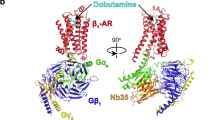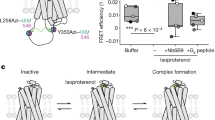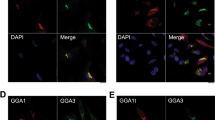Abstract
Signalling by G proteins is controlled by the regulator of G-protein signalling (RGS) proteins that accelerate the GTPase activity of Gα subunits and act in a G-protein-coupled receptor (GPCR)-specific manner1,2,3,4. The conserved RGS domain accelerates the G subunit GTPase activity5, whereas the variable amino-terminal domain participates in GPCR recognition6. How receptor recognition is achieved is not known. Here, we show that the scaffold protein spinophilin (SPL)7, which binds the third intracellualar loop (3iL) of several GPCRs8,9,10, binds the N-terminal domain of RGS2. SPL also binds RGS1, RGS4, RGS16 and GAIP. When expressed in Xenopus laevis oocytes, SPL markedly increased inhibition of α-adrenergic receptor (αAR) Ca2+ signalling by RGS2. Notably, the constitutively active mutant αARA293E (the mutation being in the 3iL) did not bind SPL and was relatively resistant to inhibition by RGS2. Use of βAR–αAR chimaeras identified the 288REKKAA293 sequence as essential for the binding of SPL and inhibition of Ca2+ signalling by RGS2. Furthermore, αAR-evoked Ca2+ signalling is less sensitive to inhibition by SPL in rgs2−/− cells and less sensitive to inhibition by RGS2 in spl−/− cells. These findings provide a general mechanism by which RGS proteins recognize GPCRs to confer signalling specificity.
This is a preview of subscription content, access via your institution
Access options
Subscribe to this journal
Receive 12 print issues and online access
$209.00 per year
only $17.42 per issue
Buy this article
- Purchase on Springer Link
- Instant access to full article PDF
Prices may be subject to local taxes which are calculated during checkout





Similar content being viewed by others
References
Luo, X., Popov, S., Bera, A. K., Wilkie, T. M. & Muallem, S. RGS proteins provide biochemical control of agonist-evoked [Ca2+]i oscillations. Mol. Cell 7, 651–660 (2001).
Zheng, B., De Vries, L. & Gist Farquhar, M. Divergence of RGS proteins: evidence for the existence of six mammalian RGS subfamilies. Trends Biochem. Sci. 24, 411–414 (1999).
Ishii, M. & Kurachi, Y. Physiological actions of regulators of G-protein signaling (RGS) proteins. Life Sci. 74, 163–171 (2003).
Xu, X. et al. RGS proteins determine signaling specificity of Gq-coupled receptors. J. Biol. Chem. 274, 3549–3556 (1999).
Popov, S., Yu, K., Kozasa, T. & Wilkie, T. M. The regulators of G protein signaling (RGS) domains of RGS4, RGS10, and GAIP retain GTPase activating protein activity in vitro. Proc. Natl Acad. Sci. USA 94, 7216–7220 (1997).
Zeng, W. et al. The N-terminal domain of RGS4 confers receptor-selective inhibition of G protein signaling. J. Biol.Chem. 273, 34687–34690 (1998).
Allen, P. B., Hsieh-Wilson, L., Yan, Z., Feng, J., Ouimet, C. C. & Greengard, P. Control of protein phosphatase I in the dendrite. Biochem. Soc. Trans. 27, 543–546 (1999).
Smith, F. D., Oxford, G. S. & Milgram, S. L. Association of the D2 dopamine receptor third cytoplasmic loop with spinophilin, a protein phosphatase-1-interacting protein. J. Biol. Chem. 274, 19894–19900 (1999).
Richman, J. G., Brady, A. E., Wang, Q., Hensel, J. L., Colbran, R. J. & Limbird, L. E. Agonist-regulated interaction between alpha2-adrenergic receptors and spinophilin. J. Biol. Chem. 276, 15003–15008 (2001).
Brady, A. E., Wang, Q., Colbran, R. J., Allen, P. B., Greengard, P. & Limbird, L. E. J. Biol. Chem. 278, 32405–32412 (2003).
Scheer, A. & Cotecchia, S. J. Constitutively active G protein-coupled receptors: potential mechanisms of receptor activation. Recept. Signal. Transduct. Res. 17, 57–73 (1997).
Wang, Q. et al. Spinophilin is a functional antagonist of arrestin in vitro and in vivo. Science 304, 1940–1944 (2004).
de la Pena, P., del Camino, D., Pardo, L.A., Dominguez, P. & Barros, F. Gs couples thyrotropin-releasing hormone receptors expressed in Xenopus oocytes to phospholipase C. J. Biol. Chem. 270, 3554–3559 (1995).
Gilchrist, A., Li, A. & Hamm, H. E. G alpha COOH-terminal minigene vectors dissect heterotrimeric G protein signaling. Sci. STKE 5 (118), PL1 (2002).
Cotecchia, S., Ostrowski, J., Kjelsberg, M. A., Caron, M. G. & Lefkowitz, R. J. Discrete amino acid sequences of the alpha 1-adrenergic receptor determine the selectivity of coupling to phosphatidylinositol hydrolysis. J. Biol. Chem. 267, 1633–1639 (1992).
Oliveira-Dos-Santos, A. J. et al. Regulation of T cell activation, anxiety, and male aggression by RGS2. Proc. Natl Acad. Sci. USA 97, 12272–12277 (2000).
Feng, J. et al. Spinophilin regulates the formation and function of dendritic spines. Proc. Natl Acad. Sci. USA 97, 9287–9292 (2000).
Xu, X., Diaz, J., Zhao, H. & Muallem, S. Characterization, localization and axial distribution of Ca2+ signalling receptors in the rat submandibular salivary gland ducts. J. Physiol. 491, 647–662 (1996).
Bernstein, L. S. et al. RGS2 binds directly and selectively to the M1 muscarinic acetylcholine receptor third intracellular loop to modulate Gq/11α signaling. J. Biol. Chem. 279, 21248–21256 (2004).
Ko, S. B. H. et al. A molecular mechanism for aberrant CFTR-dependent HCO3− transport in cystic fibrosis. EMBO J. 21, 5662–5672 (2002).
Zeng, W., Lee, M. G. & Muallem, S. Membrane-specific regulation of Cl− channels by purinergic receptors in rat submandibular gland acinar and duct cells. J. Biol. Chem. 272, 32956–32965 (1997).
Zeng, W., Xu, X. & Muallem, S. Gβγ transduces [Ca2+]i oscillations and Gα a sustained response during stimulation of pancreatic acinar cells with [Ca2+]i-mobilizing agonists. J. Biol. Chem. 271, 18520–18526 (1996).
Acknowledgements
We thank T. Südhof, UT Southwestern, Dallas, TX, for the brain library and S. Cotecchia, Institute of Pharm, Lausanne, Switzerland, for clones. This work was supported by the National Institutes of Health grants DE12309 and DK38938, the Peter Jay Sharp Foundation and the F.M. Kirby Foundation, Inc.
Author information
Authors and Affiliations
Corresponding author
Ethics declarations
Competing interests
The authors declare no competing financial interests.
Rights and permissions
About this article
Cite this article
Wang, X., Zeng, W., Soyombo, A. et al. Spinophilin regulates Ca2+ signalling by binding the N-terminal domain of RGS2 and the third intracellular loop of G-protein-coupled receptors. Nat Cell Biol 7, 405–411 (2005). https://doi.org/10.1038/ncb1237
Received:
Accepted:
Published:
Issue Date:
DOI: https://doi.org/10.1038/ncb1237
This article is cited by
-
RGS2 and female common diseases: a guard of women’s health
Journal of Translational Medicine (2023)
-
RGS2 drives male aggression in mice via the serotonergic system
Communications Biology (2019)
-
Distinct Roles of Protein Phosphatase 1 Bound on Neurabin and Spinophilin and Its Regulation in AMPA Receptor Trafficking and LTD Induction
Molecular Neurobiology (2018)
-
Successful overexpression of wild-type inhibitor-2 of PP1 in cardiovascular cells
Naunyn-Schmiedeberg's Archives of Pharmacology (2018)
-
Regulation of α2B-Adrenergic Receptor Cell Surface Transport by GGA1 and GGA2
Scientific Reports (2016)



